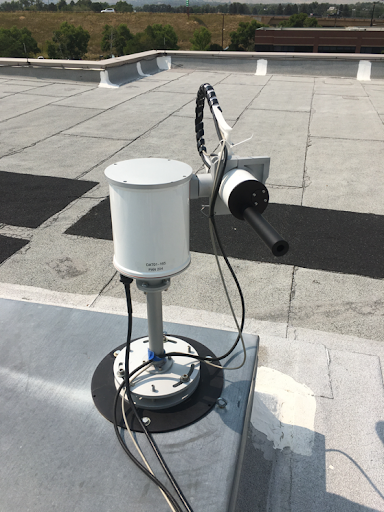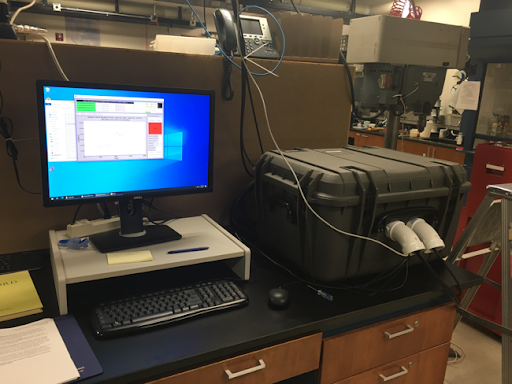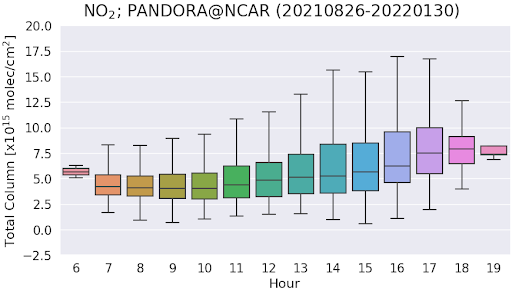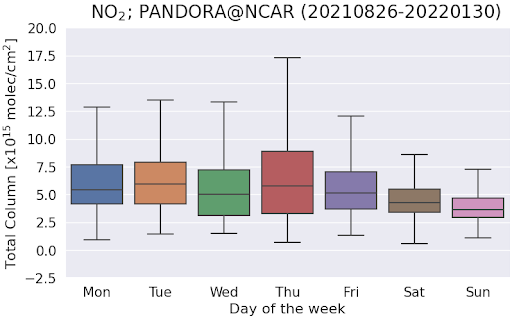PANDORA instrument at NCAR FL0
Nitrogen dioxide (NO2) and ozone (O3) are key atmospheric species that play an important role in tropospheric and stratospheric chemistry (Crutzen, 1979). The NO2 temporal variability and its vertical distribution is of great interest in order to identify ozone destruction in the stratosphere and ozone production in the lower troposphere, which together directly affect air quality and human health (Seinfeld and Pandis, 1998). NO2 in the boundary layer is influenced by natural and anthropogenic emissions making the concentrations greatly variable in both time and space. Assessing long-term fine scale variability of tropospheric gases is important for both satellite and model evaluation and for characterization of local pollution.
In 2021 ACOM acquired a ground-based PANDORA instrument, which combines direct sun and solar scattered light at multiple elevation angles (MAX-DOAS) to retrieve total and tropospheric columns of NO2, ozone, and formaldehyde (HCHO) using ultraviolet (UV) light. The PANDORA instrument was deployed in August 2021 on the roof of NCAR FL0 alongside the FTIR (Figure 1), allowing for trace gas retrievals from the IR though the UV and multispectral measurements for several species. The instrument joined the NASA Pandonia Global Network (PGN, https://pandora.gsfc.nasa.gov/PGN/), which provides quasi real-time, standardized, calibrated, and verified QA/QC AQ data.


Figure 1. a) Left: PANDORA solar tracker and head sensor on the roof of NCAR FL0. b) Right: UV spectrometer system located inside room 3164 in a controlled temperature enclosure.
A major objective is to support the validation and verification of current and upcoming satellites, including TEMPO (TEMPO will be the first ever space-based instrument to monitor air pollutants hourly across the North American continent during daytime). The PANDORA at NCAR is about 10 km from the PANDORA at NOAA, about the East-West size of a TEMPO pixel, which will allow us to quantify sub-pixel variability measured over Boulder, Colorado with complex topography and meteorology.
Figures 2 and 3 show initial analysis of the distribution of NO2 total columns in box-whisker plots for the diurnal variation and day of the week, respectively. The top and bottom of the box and the top and bottom whiskers represent the 75th and 25th and the 95th and 5th percentile, respectively), including median values (red horizontal lines). A dedicated webpage showing daily total and tropospheric columns along with statistics has been created (https://www.acom.ucar.edu/pandora/).


References
Crutzen, P. J. (1979), The role of NO and NO2 in the chemistry of the troposphere and stratosphere, Annu. Rev. Earth Planet. Sci., 7, 443– 472.
Seinfeld, J. H., and S. N. Pandis (1998), Atmospheric Chemistry and Physics—From Air Pollution to Climate Change, John Wiley, New York.
Team
Ivan Ortega (NCAR/ACOM)
James Hannigan (NCAR/ACOM)
David Edwards (NCAR/ACOM)
Carl Drews (NCAR/ACOM)
Garth D'Attilo (NCAR/ACOM)